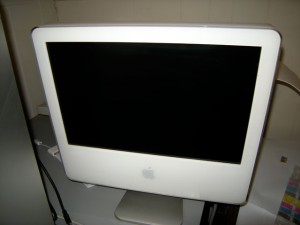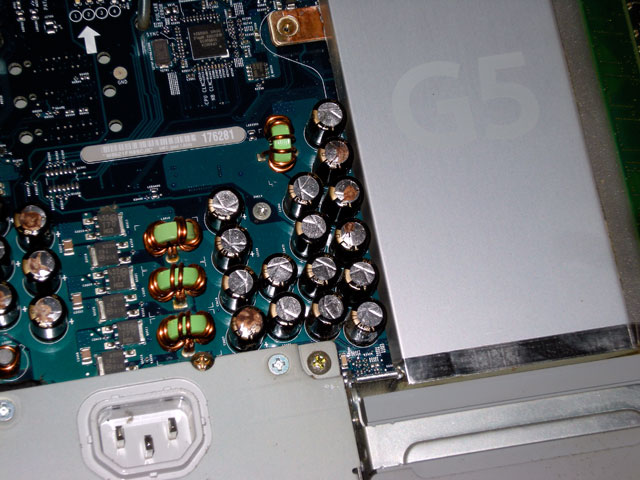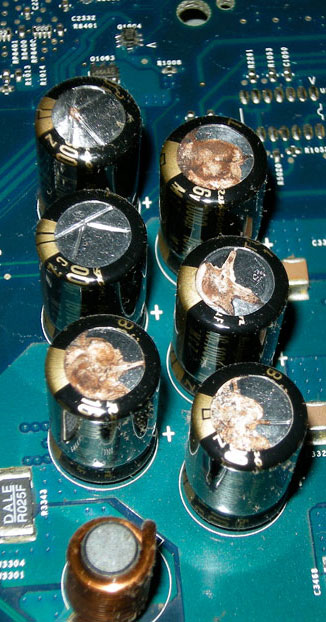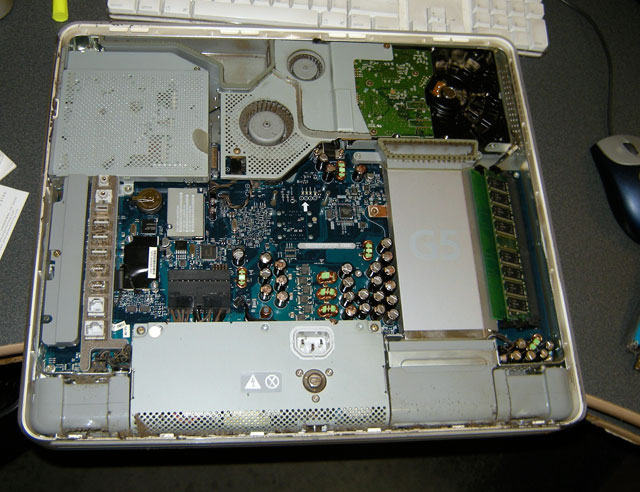 Recently I was given the task of hopefully resuscitating a 17″ G5 iMac that is roughly 6 years old, and, in classic fashion, was working just fine until something weird started to happen according to its user. The user is a graphic designer who got the Mac new and used it heavily as a production machine. It served her well until the display started to crap out. This was turning into a panic situation because it was the designer’s only Mac and her clients were massing like a hoard of barbarians outside of her gates.
Recently I was given the task of hopefully resuscitating a 17″ G5 iMac that is roughly 6 years old, and, in classic fashion, was working just fine until something weird started to happen according to its user. The user is a graphic designer who got the Mac new and used it heavily as a production machine. It served her well until the display started to crap out. This was turning into a panic situation because it was the designer’s only Mac and her clients were massing like a hoard of barbarians outside of her gates.
So I took a look at it. I set the computer face down on its screen and popped off the back. The back panel with attached foot comes off with the turn of a few screws and is a lot easier to open up than the original iMac, G4 eMac and the G4 iMac with the rice bowl bottom. Looking down at the guts of the machine I saw what the problem was right away.
 Most of the
Most of the m were swelling and a number of them had ruptured and were leaking the electrolyte from within as you can see by the brown crud on top of these things. I was amazed we could get the iMac to work at all. Starting the machine as normal resulted in distorted or non-existent video, but it seemed all right when started in Safe-Boot.
m were swelling and a number of them had ruptured and were leaking the electrolyte from within as you can see by the brown crud on top of these things. I was amazed we could get the iMac to work at all. Starting the machine as normal resulted in distorted or non-existent video, but it seemed all right when started in Safe-Boot.
I had encountered this capacitor issue before when Dan Love and I started looking at a mutual friend’s 20″ iMac that was having video problems. That Mac looked a lot better than the Mac above, but there was some of the telltale swelling on a couple of the capacitors. The owner opted to have the logic board sent out to a repair service that would replace the bad caps. Sadly, it didn’t work out. Once the board was returned and replaced in the machine, it worked fine for a while, but than started to behave erratically and have kernel panics left and right. The owner gave up in disgust. Neither I nor Dan could really invest the time to possibly get it running again. The particular capacitor service promised to replace the capacitors and that’s what they did, but they mainly deal with PCs and openly admit that they are not equipped to test out Macs. If there is a Apple-centic service that replaces capacitors, I’d really like to know.
I’m not sure if this Mac is a victim of the Capacitor Plague or if it’s just a machine that’s been beaten like a rented mule. I was never a fan of all-in-one machines because if one element gives up, you have a huge paper weight on your hands that may not be that easy or cost effective to repair especially when proprietary parts are not readily available. I’m also not crazy about all of that computer crammed into a cramped and hot pizza box. Sure, the industrial design is beautiful, but I would still use Macs if they came in beige plastic boxes.
Anyway…
I took the hard drive from the iMac and slapped it into an idle G5 PowerMac tower, and she got her computer back. I would have liked to spend more time with it, but both the graphics designer’s boss and clients were breathing down her neck. I think a new hard drive wouldn’t have been a bad idea.
My advice is that if you make a living or rely heavily on your computers, it wouldn’t be a bad idea to have a back up computer. I’ve bought most of my Macs used, and, to me, that’s the way to go! There are a number of reputable dealers out there, and being that Mac users seem to shed their old equipment for the always newly arrived machine, there are plenty of second hand machines out there CHEAP! Do a little research. LowEndMac is an excellent source.
NOTE:
The best way to recycle a Mac is to re-use it. For the past few years I’ve been getting my hands dirty under the hoods of old Macs swapping parts and performing upgrades. This is a new category that I will post to every now and then about mostly Apple computers. Due to my love of computers, my lack of funds and the wealth of information easily available on the internet, I’ve taken it upon myself to become my own fix-it man. I am not the handiest guy in the world, but, thanks to research on the internet, I’ve been able to cobble together and hot rod a few Macs into completely viable machines. It gives me a real Mechanics Illustrated sense of accomplishment, and puts me in touch with my dear departed Dad.






I came here after seeing your flickr page … this is a very interesting artcle, and I will be sure to check out the insides of my Dad’s mac graveyard, when I see him next. I have a feeling I will be getting the desoldering tool out!
Thanks =]
Thanks for commenting!
I envy you your soldering skills. I’ve soldered copper tubing, but never electronics. That’s the next thing I’m going to learn.
One trick to electronic soldering is the use of the heat sink. Temperatures hot enough to melt solder (rosin core, never acid) are often high enough to fry semi-conductors. Make sure you have a heat sink you can place between the solder joint and the component.
Thanks for the info. I was going to buy some kits to get a feel for it. I’m also thinking of scavenging this cruddy logic board to practice.